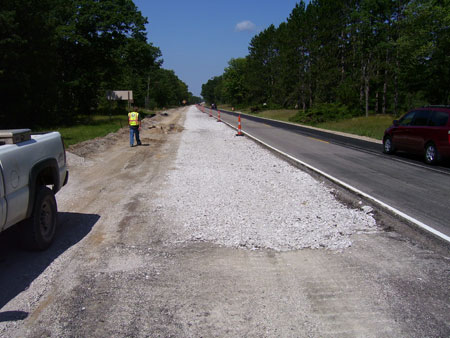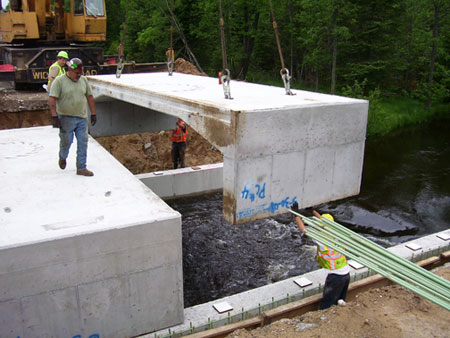U.S. Department of Transportation
Federal Highway Administration
1200 New Jersey Avenue, SE
Washington, DC 20590
202-366-4000
Focus
| Accelerating Infrastructure Innovations |
Publication Number: FHWA-HRT-13-008
Date: November 2012
Printable Version (.pdf, 0.3 mb)
Every day transportation agencies across the country face the challenge of carrying out high quality construction projects on time and within budget, all while meeting the expectations of the traveling public.
As agencies contend with aging highway infrastructure, increased congestion, and shrinking budgets, they continue to look for new methods to meet these challenges and complete projects better, faster, safer, and more cost effectively.
Performance contracting offers agencies an alternative to standard low-bid contracts with detailed specifications, allowing for increased innovation and problem solving. Under a performance contract, agencies specify performance goals and contractors have flexibility in how they carry out the work to meet those goals.
"The agency can clearly communicate to the contractor what they are trying to achieve with the project, and the contractor shares the risks and rewards through incentives and disincentives," said Jerry Yakowenko of the Federal Highway Administration (FHWA).
FHWA's newly updated Performance Contracting for Construction: A Guide to Using Performance Goals and Measures to Improve Project Delivery offers State and local transportation departments a valuable reference, walking them through the process for using performance contracting on a typical reconstruction or rehabilitation project. Originally developed in 2006, the 2012 update includes lessons learned and sample materials from a successful performance contracting pilot project conducted by the Michigan Department of Transportation (MDOT).
The guide includes recommended processes and sample materials for:
Each section in the guide describes a suggested process to follow, presents lessons learned from real-world contracts, and provides sample materials for project solicitations. When selecting performance contracting projects, for example, considerations include whether an agency can legally use an award process other than low-bid, if a contractor will be allowed flexibility in its approach to the project, if an agency has adequate resources to conduct performance measurement, and whether the project risks are balanced by adequate rewards. As noted in the guide, performance contracting can be applied to any size contract, not just large projects.
The guide includes sample performance measures developed for use on highway construction projects. Categories include safety, construction congestion, quality, time, cost savings, customer satisfaction, environmental sustainability, and innovation. Each performance measure has five levels of performance. "While agencies will need to develop a set of goals that suit their specific project, this sample menu will provide a head start and help to accelerate the process," said Yakowenko.
Also featured are details on the process used for MDOT's $3.8-million pilot project on M-115 in Clare County. The pavement on this rural 8.9-km (5.56-mi) stretch of a two-lane highway was in poor condition, and two bridges needed significant reconstruction. Michigan received $1 million in project funding from FHWA's Highways for LIFE (HfL) program and used HfL's Performance Contracting for Construction Implementation Framework. This framework was developed with input from several State highway agencies, the Associated General Contractors of America, and the American Road and Transportation Builders Association.
Performance goals for the 2008 project focused on the measures MDOT and its stakeholders wanted the project to achieve in the following categories: date open to traffic, completion of construction and related cleanup, pavement performance, worker safety during construction, work zone crashes, and motorist delay.
MDOT awarded the project to the contractor whose proposal represented the best value considering price, goals, and proposed innovations. Contractor innovations used for the project included prefabrication of the new bridge decks and installation of a 3.3-m (11-ft) wide temporary traffic lane that provided two-way traffic during major construction stages. A 24-hour roadside patrol also offered motorist assistance within the construction zone. Project successes included reopening the roadway to traffic 20 days early.
To download a copy of Performance Contracting for Construction: A Guide to Using Performance Goals and Measures to Improve Project Delivery, visit www.fhwa.dot.gov/construction/contracts/pcfc_2012/pcfc00.cfm. The HfL Performance Contracting for Construction Implementation Framework is available at www.fhwa.dot.gov/hfl/framework. For more information on performance contracting, contact Jerry Yakowenko at FHWA, 202-366-1562 (email: gerald.yakowenko@dot.gov).

Using performance contracting, the Michigan Department of Transportation rehabilitated an 8.9-km (5.56-mi) stretch of M-115 in Clare County. (Photo Credit: © MDOT).

The mid-section of the precast superstructure for a bridge on M-115 is placed as part of the Michigan Department of Transportation's performance contracting project. (Photo Credit: © MDOT).